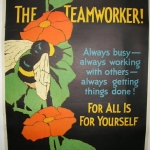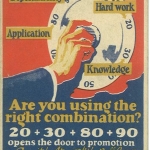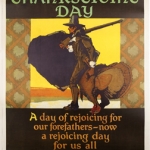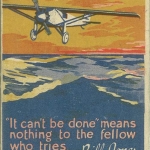Ninety plus years ago, various American companies produced motivational posters and cards meant to promote industrial efficiency and ethical behavior in the work place by “educating . . . employees to think and act along constructive lines . . . .” [ii] These prints encouraged good character through the promotion of motivational sayings paired with high quality illustrations elaborating the story or moral at hand.
Early in the 1920s Charles Mather, who worked for his family’s Chicago printing house, the Mather Company, took an idea brought to him by one of the firm’s salesmen, Charles Howard Rosenfeld.[iii] What Rosenfeld proposed was a series of posters whose focus was to give workers incentive to work better and to work harder. Mather called these prints, “Constructive Organization Posters.” These posters were made to be placed on office and factory walls and were expected to inspire workers to do their best. Mather sold his posters by subscription and produced more than 300 varieties between 1923 and 1929.[iv]
In 1925 Rosenfeld and another employee broke from Mather to form their own company, the C. J. Howard Company, to sell incentive cards to be displayed on desks in a re-useable easel. During this same period the English firm Parker Holladay Company was producing Bill Jones motivational posters. The Parker Holladay firm’s American office also located in Chicago made Bill Jones (a fictional character) trading-sized cards for the American market with the catch title, “Have you Met Bill Jones?”
These cards and posters were printed as multicolored lithographs to produce easily readable images accompanied by tagline messages promoting such admirable qualities as teamwork, punctuality, loyalty, and safety. But what strikes me most is the concept of character education and the mottos that encourage better behavior are one of the legacies of the Arts & Crafts movement.
When Americans embraced the progressive Arts & Crafts movement (involving architecture, interior decoration, household taste and life-style choices), they continued the William Morris tradition of including motivational sayings often carved or painted onto their fireplace over-mantel. In Buffalo, NY, The Larkin Soap Company’s 1906 Administration Building, designed by Frank Lloyd Wright, included painted mottos throughout its five-story atrium. Other Arts & Crafts entrepreneurs like Roycroft’s creator Elbert Hubbard (John D. Larkin’s brother-in-law, who resigned from Larkin Soap in 1893) used motivational quotes in their writings and to adorn household spaces and items.[v] Roycroft also produced a variety of publications that included or were dedicated to epigrams.[vi]
An Elbert Hubbard quote equivalent to something you might find on a Bill Jones card might be, “An ounce of loyalty is worth a pound of cleverness,” or “Boredom is a Matter of Choice not Circumstance.” Other movers and shakers of the early 20th century also used mottos to set the stage for their products or to give the public a sense of who they were. For instance Henry Ford used this saying as his motto, “Chop Your Own Wood and It Will Warm You Twice.”
If you think about it, these sayings and mottos while instructional at their core, are a quick and effective way to remind ourselves what Geoffrey Chaucer, the English 15th century writer and poet knew, “To maken vertue of necessite.”

 The Teamworker! 1929 Are you using the right combination? 1927
motivational poster Bill Jones motivational card
The Mather Company of Chicago The Parker-Holladay Company, Chicago
The Teamworker! 1929 Are you using the right combination? 1927
motivational poster Bill Jones motivational card
The Mather Company of Chicago The Parker-Holladay Company, Chicago
My thanks to Drs. Dan R. and Lois F. Fermaglich for introducing me to Bill Jones Motivational Trading Cards.
November 17, 2011
By Joyce K. Schiller, Curator, Rockwell Center for American Visual Studies, Norman Rockwell Museum
[i] “It began with a dream. A dream of the perfectly-realized American company. A company that would create dissatisfied customers in the process of exploiting demoralized employees while selling overpriced and ineffective products to remediate the problems cause by the very process itself.” From the Demotivators website, www.despair.com.
[ii] “Parker-Holladay Poster Service” in Machinery v. 28 (October 1921): 170.
[iii] Charles Rosenfeld’s niece believes that he only worked for Mather until c. 1925.[iv] Robert Klara, “The Art of Enterprise: A Chicago Advertising Executive’s Crusade for Greater Production Through Beautiful Posters” in American Heritage v. 52, no. 4 (June 2001).
[v] Roycroft was an Arts and Crafts movement community in East Aurora, NY founded in 1895. The Arts and Crafts Movement was an aesthetic movement that flourished in the late 19th and early 20th centuries. Begun in Britain by social reformers Walter Crane, John Ruskin, and designer William Morris, it was a reaction against the tastes of the Victorian era and the “soulless” machine-made products of the emerging Industrial Revolution. Their belief was that good design correlated to the notion of a good society. Workers under hardship by the working conditions and machines found in factories often created goods that were poor in design and quality. The movement’s aim was to re-establish a harmony between architect, designer and craftsman, and to produce handmade, well-designed, affordable, everyday objects. These products would enhance the lives of ordinary people while providing fulfilling work for the craftsman.
[vi] The Motto Book (East Aurora, NY: Roycroft Press, 1907); 1001 Epigrams (East Aurora, NY: Roycroft Press, 1910). Many of these same mottos were included in Hubbard’s The Philistine a magazine published between 1895 and 1915, and The Fra subtitled, A Journal of Affirmation.








